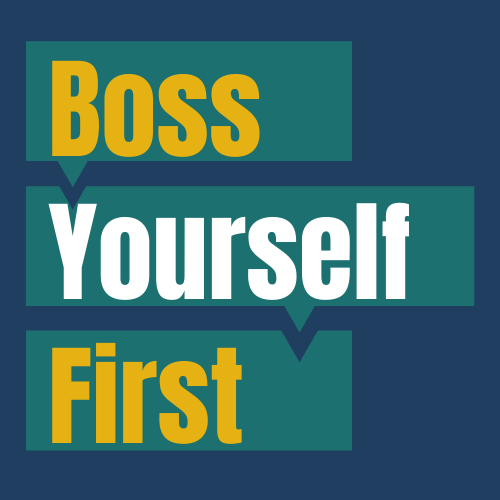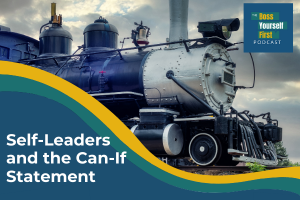Self-Leaders and the Can-If Statement
Remember the Little Engine that Could? Today we’re talking about the little engine of processing constraint – the Can-If statement. Self-leaders learn to power their creativity and innovation around constraint processing with a simple (but not always easy) flip from seeing obstacles to finding solutions. Learn how on today’s episode.
Episode Transcript
Boss Yourself First –
BYF Season 2 Episode 4
Hello, Hello everyone! How are you doing right now? I like to picture you all listening as you go about your busy lives. Thanks so much for hanging out here with me as you go for a walk or load the dishwasher or commute to work. We’re doing well here. Waiting for our vaccine time, so far it looks like sometime this summer. But hey, time is flying by, at the time you’re hearing this it’s around Valentine’s Day, so summer is just around the corner. This season we’re talking about transforming constraint. And in our last episode I challenged you to start working on your question thinking when you encounter a challenge by asking yourselves – what assumptions am I making and how else can I think about this? We’re working on questions because it is questions that enable us to move through the process of leveraging constraint to build momentum toward reaching our goals. So today, we get into the questions that will actually get us to solutions. Are you ready to move forward? First step is to frame the constraint and our goal into what the authors of A beautiful constraint call a propelling question? Before I give examples of a propelling question, I want to recount a story told by Morgan and Barden in their book. The story is about Audi trying to win a race in Les Mans, France. Remember that race portrayed in Ford Vs Ferrari? That 24-hour endurance race. So, their goal was to win the Les Mans race and the obvious solution would be to build a faster car. However, they believed they had maxed out the speed capabilities of their designs and that became the constraint. So their propelling question was born. “How could they win the race if their car could not go faster than the other cars? They figured out that they could win the race if they took fewer pit stops and so their focus turned to fuel efficiency. They used diesel fuel for the first time in their race cars and won the Les Mans Race, not just in 2006, but for three years in a row. They believed they didn’t have the resources to build a faster car. So, did you catch the structure of the propelling question? An ambition goal plus a major constraint. How can I choose a college without ever visiting campus? How can I run a restaurant without having diners in my café? How can I create a cohesive team that is never physically together? How can I launch a business without capital?
I want to stop just for a minute here in our propelling question and refocus on the goal. Don’t just breeze over the goal to identify the constraint and jump into solutions. Really look at that goal. What does success here really look like? How would it feel to achieve it? What will happen because you achieve it? What if it’s better than you can even imagine?
Take the time to really vision out the result of leveraging this constraint.
Okay back to our next step:
I’m hoping the propelling question came pretty easily, especially as we are becoming such skilled question thinkers.
Once you feel you’ve captured your propelling question. (Oh also, you may go back and adjust your propelling question if it becomes apparent that you’ve misidentified the constraint. But once you have your propelling question, it’s time to get solution focused.
To really answer our propelling questions, we must turn can’t because statements into can if statements.
For example,
I can’t win the Les Mans race because I can’t create a faster car to
I can win the Les Mans race if I have fewer pitstops for refueling.
I can’t run a restaurant because I can’t have inside dining. To I can run a restaurant if I use my staff to take online orders and execute curbside pickup.
Barden and Morgan emphasize the power of the Can If Statement –
A can if statement keeps the conversation productively focused. They say, “It keeps the conversation about how something could be possible, rather than whether it would be possible
A can if statement fuels optimism and curiosity
A can if statement keeps everyone looking for solutions instead of identifying barriers
It boosts our sense of self as transformers, problem solvers instead of victims
According to Barden and Morgan and this is maybe my favorite is “It is a method that maintains a mindset. The failure to generate an answer with one line of enquiry simply leads to another ca-if, another how.” That’s my favorite because you just keep producing can if statements. Meaning if you find a solution with one can-if statement that ends without the desired result, failure, you simply use the data from that failure to iterate a new can-if statement and try again. It’s a method that supports leveraging constraint because be ready, Barden and Morgan warn that often dealing with one constraint often reveals another constraint or more before the desired end result. Again, it’s a process!
Remember that we are aiming for the transformer state where we don’t lower our goals to fit the constraint, but we actually view the constraint as a gift or tool to improve creativity and accelerate innovation. The other night, my husband asked me on a date, in our basement. He fixed dinner and let our daughters handle the clean-up. While we ate we watched a show we frequently watched back when we were newlyweds called “Whose Line is it Anyway?” It’s an improv show where the actors are given different games to play that require them to improvise taking on different character roles, emotions, making up songs with different rules each time. Watch that show, and you’ll see how they treat the constraint of the rules. When doing improv every participant has to have a “Yes, And mentality. If you’re partner starts a scene where they are an alien in a car wash you take that as a gift and build your story on that premise. If you go the other way the “No, but” way – you kill the momentum of the scene, disengage your audience and handcuff your fellow actors. This is what a transformer does with constraint when they formulate the “Can-if” questions.
So, you know how this works, it’s your turn. My challenge for you this week is to formulate a propelling question around a constraint you are experiencing or even imposing. Then get your “Can-if” statements rolling. Now if the can if list is too difficult at first, then start with the list of “can’t because’s” and then one by one, turn those statements into “can- if’s”.
I hope you take this challenge, if you want help, join the Boss Yourself First Facebook group and we’ll hash it out together. Also, keep tuning in, I will be announcing a new self-leadership opportunity in just a few weeks. I’m really excited about it and I’m looking forward to sharing here with you. Next week we’re talking about creating abundance in constraint. Until then, take care everyone.

